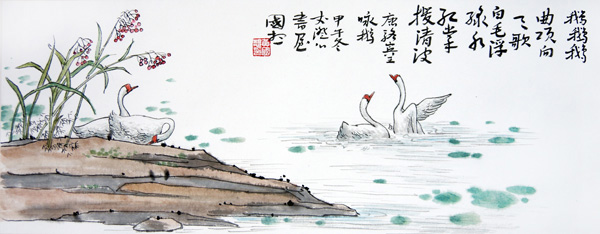
Illustration for Ode to Goose by Huang Guoxiang. (Photo/66wz.com)
Primary school students in China will start using new editions of their textbooks this coming September, with new illustrations that will help them understand classic Chinese poems.
To accompany the 110 classic poems included in 12 volumes of Chinese for primary school students from Grade One to Six, one hundred illustrations were painted by artist Huang Guoxiang of Wenzhou, Zhejiang province.
"Illustrations coupled with ancient poems used to be painted using fountain pens, which differs somewhat from the artistic conceptions that Chinese poems aim to express. I think traditional ink painting suits Chinese poems more," said Huang during an interview with thepaper.cn.
The old version of Chinese has been in use for more than a decade.
"Our aesthetic tastes, in adults and children alike, have changed somewhat. The illustrations in textbooks should keep up with that," said Huang.
The 2016 edition of Chinese, published by People's Education Press, has already been approved by China's Ministry of Education. Volume one for first-graders has already been published, and the textbooks for other grades will gradually be replaced starting next semester.
"An editor from People's Education Press called me last September and asked whether I was interested in painting illustrations for the new edition of Chinese. My task was to create illustrations for three poems: Ode to Goose, Min Nong and Spring Dawn, and I spent two weeks working on them. After about 20 days, the publisher called me again and asked me to illustrate for all 12 volumes of Chinese from Grade One to Six," Huang said.
Huang said he referred to the Chinese textbooks his son used previously before working on a new painting.
"The strokes made by fountain pens tend to be harsher. The flow of the ink in ink painting expresses the mood of the poem better," he said.
But he did not just create any ink paintings; Huang tailored his style of painting for his target readers. Primary school students may not necessarily be attracted to traditional Chinese ink painting, as the strokes tend to be thick and the colors dark. So he fused ink painting with watercolor to make the pictures visually appealing to the young readers while fully expressing the essence of classic poems.
For instance, for the poem Ode to Goose, a work that's widely known in China, Huang focused on expressing the gestures of the goose clearly to readers. The goose on shore should raise its neck high as if singing to the sky, and the white feathers of the goose in the water should float gracefully while its feet pedal in the green waters, which are all expressed in the poem.
"It's not that difficult to illustrate a single poem. The hard part is, sometimes there are three poems on one page and the contents of these poems may vary greatly, so it was challenging for me to express the moods of all of them with one illustration. Sometimes I had to think with a bigger picture and create something that fits it all," added Huang.
Huang and the editors exchanged the most views on the style of clothing for the people in the illustrations and whether they fit the era in which the poem was created. "They didn't say anything about the style of my paintings," Huang added.


















































